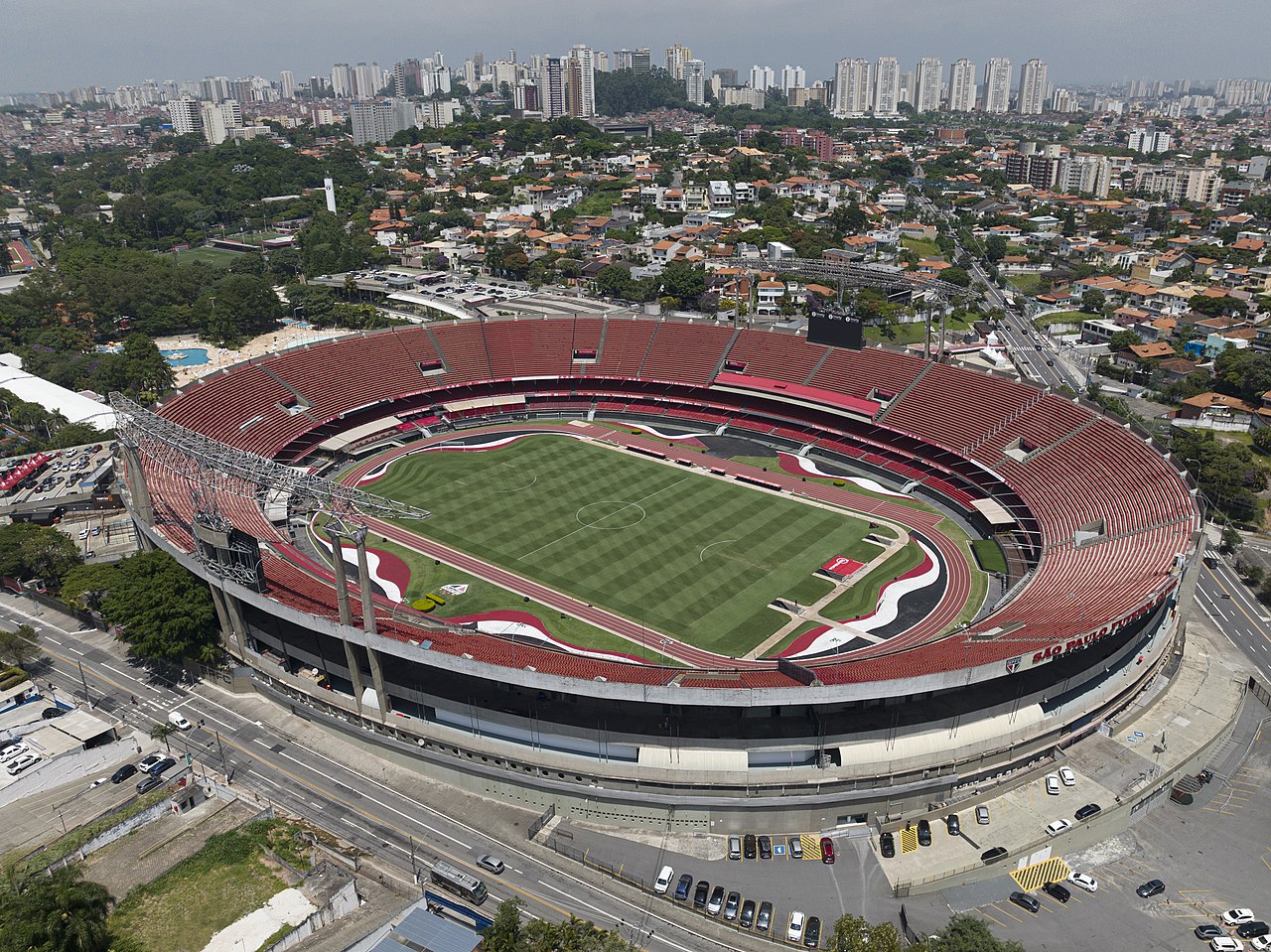Embark on an exhilarating voyage through the captivating realm of Brazilian sports as we unveil the alluring world of the country’s most esteemed stadiums. Home to legendary matches and brimming with historical relevance, these architectural marvels serve as beacons of athletic prowess and communal celebration. From the iconic Estadio Jornalista Mario Filho, affectionately known as Maracana, to the state-of-the-art Arena BRB, each venue paints a vivid portrait of Brazil’s deep-rooted sports culture. Step into the hallowed Estadio Cicero Pompeu de Toledo, witness the awe-inspiring Estadio Governador Placido Castelo, and pay homage to the legendary Estadio Governador Magalhaes Pinto. Journey through the illustrious Arena do Gremio, experience the magical Estadio Jose Pinheiro Borda, and be captivated by the modern splendor of Neo Quimica Arena. Immerse yourself in the passion of Itaipava Arena Fonte Nova and be awe-struck by the grandeur of Estadio Governador Carlos Wilson Campos. Join us as we unravel the enchanting tales woven into the fabric of these remarkable Brazilian stadiums.
1. Estadio Jornalista Mario Filho
Estadio Jornalista Mario Filho, also known as Estadio do Maracana, is a football stadium located in Rio de Janeiro, Brazil, in the vibrant continent of South America. With a seating capacity of 78,000 spectators, this iconic sporting venue attracts passionate fans from all corners of the globe.
Originally constructed in 1950, the stadium has undergone several renovations to ensure an unparalleled sporting experience. Its rich history includes hosting memorable matches, including World Cup finals and the 2016 Olympic Games.
Situated within the heart of Rio de Janeiro, the Estadio Jornalista Mario Filho holds immense significance in the local community. It is not just a mere football stadium; it is a symbol of passion, pride, and camaraderie amongst fans. The energy that resonates within its walls is palpable, making it an electric atmosphere for both players and spectators alike.
As you step into this hallowed ground, you are transported into a world of sporting glory. The stadium’s facilities rival those of any top-tier venue, with state-of-the-art features and amenities to enhance the overall experience. From the impeccable pitch to the world-class dressing rooms, every aspect has been meticulously curated to ensure every visit is a memorable one.
Estadio Jornalista Mario Filho is more than just a stadium. It is a testament to the power of sport in bringing people together, igniting emotions, and creating lifelong memories. A visit to this iconic arena is an absolute must for any sports enthusiast seeking to embrace the electric spirit of Rio de Janeiro.
2. Arena BRB
Arena BRB, located in the vibrant city of Brasilia, Brazil, is a football stadium that stands as a testament to the nation’s deep-rooted love for the beautiful game. With a seating capacity of 72,000, this colossal arena becomes a cauldron of energy and passion as fans from all corners of South America come together to support their beloved teams.
First established in [year], Arena BRB has been a witness to countless historic moments on the football field. Whether it’s the deafening roars of the crowd, the thunderous applause for a winning goal, or the collective gasps of anticipation, the stadium exudes an electric atmosphere that captivates all who enter.
But beyond its architectural splendor and remarkable seating capacity, Arena BRB holds a special place in the hearts of the local community. It serves as a unifying force, bringing people together under the shared joy of football. It is a sanctuary where dreams are born and legends are made, forever etching itself into the fabric of Brasilia’s sporting culture.
As fans stream into the stadium, anticipation hangs heavy in the air, blending with the intoxicating scent of freshly cut grass. The vibrant colors of the team banners and jerseys add a mesmerizing tapestry of hues to the spectacle. From the moment the first whistle blows, the stadium becomes an arena of dreams, where heroes are made and where the impossible becomes reality.
Arena BRB is more than just a football stadium; it is a pulsating heartbeat, an emblem of unity, and an unbreakable bond between the community and the beautiful game. Step inside, stand witness to the raw emotion that floods the stands, and become a part of this sensational footballing experience.
3. Estadio Cicero Pompeu de Toledo

Estadio Cícero Pompeu de Toledo, widely known as Morumbi, is an iconic football stadium that stands tall in the eponymous district of São Paulo, Brazil. This majestic stadium, with its grandeur and rich legacy, is the proud home of São Paulo Futebol Clube, one of the most successful clubs in Brazilian football history.
Stepping inside this remarkable venue, one cannot help but feel the weight of history that surrounds it. The stadium’s formal name pays homage to Cícero Pompeu de Toledo, a revered figure in the São Paulo Futebol Clube’s history. Serving as the chairman during the majority of the stadium’s construction, Pompeu de Toledo tragically passed away before witnessing the inaugural match.
Estadio Cícero Pompeu de Toledo holds an incredible seating capacity of 66,000, ensuring an electrifying atmosphere for both players and spectators alike. It stands as a testament to the fervent passion Brazilians hold for the beautiful game and is one of the largest privately owned stadiums in the country.
Situated in the vibrant city of São Paulo, Estadio Cícero Pompeu de Toledo has become a symbol of pride and unity for the local community. Its towering architecture and captivating aura have forged unforgettable memories for football enthusiasts, acting as a rallying point for fans to come together and support their beloved club.
Estadio Cícero Pompeu de Toledo, a true footballing marvel, continues to mesmerize visitors, offering an immersive experience that celebrates the illustrious history and enduring spirit of São Paulo Futebol Clube.
4. Estadio Governador Placido Castelo
Estadio Governador Placido Castelo, also known as the Castelão Stadium, is a magnificent football arena nestled in the vibrant city of Fortaleza, Brazil. With a seating capacity of 63,000, this stadium creates a breathtaking atmosphere for football enthusiasts, igniting a passion that electrifies the entire community.
Dating back to 1973, the Estadio Governador Placido Castelo has been a symbol of sporting excellence, hosting numerous thrilling matches and witnessing unforgettable moments. Strategically located in the heart of Fortaleza, it serves as a focal point for sports fans, attracting visitors from far and wide who crave an unforgettable football experience.
Apart from its undeniable beauty and remarkable size, the significance of Estadio Governador Placido Castelo extends beyond the football pitch. It serves as a hub for the community, fostering a sense of unity and camaraderie among its residents. The stadium has become a melting pot of emotions, where dreams are realized, and legends are born.
Immerse yourself in the passionate chants and cheers emanating from the stands, feel the pulse of every goal and celebration, and bask in the awe-inspiring beauty of Estadio Governador Placido Castelo. Whether you are a die-hard football fanatic or simply appreciate the power of sports, this iconic stadium is a must-visit destination in South America.
5. Estadio Governador Magalhaes Pinto
Estadio Governador Magalhaes Pinto, affectionately known as Mineirao, is not just a football stadium, but a symbol of passion, unity, and sporting excellence. Located in Belo Horizonte, Brazil, in the vibrant South American continent, this iconic arena has captured the hearts of football fanatics around the world.
With a massive seating capacity of 61,000, every matchday at Mineirao is a spectacle. The energy and fervor generated by the passionate fans create an electric atmosphere that reverberates throughout the stadium, making it a truly unforgettable experience for both players and spectators.
But Mineirao is more than just an architectural marvel; it holds a significant place in the hearts of the local community. Generations of football enthusiasts have flocked to this sacred ground, forming a bond that transcends borders and inspires collective pride. From historic rivalries to thrilling victories, the stadium has witnessed countless unforgettable moments that have shaped the rich footballing heritage of Belo Horizonte.
Beyond the football pitch, Mineirao is a source of unifying joy. It hosts various cultural events, concerts, and gatherings that bring people together, fostering a sense of camaraderie and celebration. The stadium’s grandeur and majestic presence make it a symbol of hope, resilience, and the power of unity.
Estadio Governador Magalhaes Pinto is not merely a football stadium; it is a symbol of unwavering passion, a testament to the spirit of sport, and a cornerstone of the local community.
6. Arena do Gremio

Arena do Grêmio, located in Porto Alegre, Rio Grande do Sul, Brazil, is a magnificent multi-use stadium that was inaugurated on December 8, 2012. Considered one of the most modern venues in South America, this spectacular stadium holds an impressive seating capacity of 60,000, offering a thrilling atmosphere for football matches. As the home stadium of Grêmio Foot-Ball Porto Alegrense, Arena do Grêmio has become an iconic symbol for the club and a cherished gathering place for passionate fans. Not only does this state-of-the-art stadium meet the highest standards set by the Brazilian Ministry of Sport’s football stadium evaluation system, Sisbrace, but it has also obtained a prestigious “Category Four” evaluation from UEFA. Despite not being a host venue for the 2014 FIFA World Cup, Arena do Grêmio gained recognition on an international stage when it was selected as one of the venues for the 2019 Copa América, hosting five memorable matches. This sports haven not only showcases extraordinary architecture and top-notch facilities but also holds immense significance in the local community, serving as a symbol of pride, unity, and sporting excellence.
7. Estadio Jose Pinheiro Borda
Estadio Jose Pinheiro Borda, also known as Estadio Beira-Rio, stands proudly in the vibrant city of Porto Alegre, Brazil. This iconic football stadium has been a symbol of passion and athleticism since its establishment. With a seating capacity of 50,000, it offers an exhilarating atmosphere that electrifies the air during every match.
Constructed in [year], Estadio Jose Pinheiro Borda has witnessed countless memorable moments that have left fans in awe. The stadium’s location, strategically situated in the heart of the city, ensures easy accessibility, inviting fans from far and wide to experience the magic of football in this extraordinary venue.
Beyond the thrilling matches, Estadio Jose Pinheiro Borda holds deep significance in the local community. It serves as a cultural hub, bringing people together and unifying them under the common love for the beautiful game. The stadium has become an integral part of the city’s identity, fostering a sense of pride and camaraderie among its residents.
As fans flock to the stands, the stadium’s architectural marvel and state-of-the-art facilities captivate their senses. The modern design provides optimal viewing angles and comforts, ensuring that spectators have an unforgettable experience. With its rich history, prime location, and undeniable charm, Estadio Jose Pinheiro Borda continues to leave an indelible mark on the world of football, solidifying its place as a true gem in South America.
8. Neo Quimica Arena

Located in São Paulo, Brazil, the Neo Quimica Arena, also known as Arena Corinthians, stands as a testament to the passion and dedication of football enthusiasts in South America. With a seating capacity of 49,205, this magnificent stadium is a hub of excitement and energy. Its significance in the local community cannot be overstated, as it serves as the home of Corinthians, one of the most revered football clubs in Brazil.
The history of the Neo Quimica Arena is one of transformation and growth. Originally constructed in 2014 for the FIFA World Cup, the stadium has evolved into an iconic landmark of the city. Its fame is not limited to its architecture, as it hosted six electrifying matches during the prestigious tournament, including the unforgettable opening match.
Nestled in the heart of São Paulo, the Neo Quimica Arena captures the vibrant spirit of Brazilian football. The stadium’s modern design and state-of-the-art facilities ensure an unmatched experience for both players and fans alike. From the thrilling roar of the crowd to the pulsating energy in the air, every match in this extraordinary venue leaves an indelible mark on the memories of those fortunate enough to witness it.
In conclusion, the Neo Quimica Arena stands tall as a symbol of sporting excellence and community pride. With its capacity to bring people together and create unforgettable moments, this football temple continues to be a source of inspiration for all who walk through its gates.
9. Itaipava Arena Fonte Nova

The Itaipava Arena Fonte Nova, officially called the Complexo Esportivo Cultural Professor Octávio Mangabeira, stands proudly in Salvador, Bahia, Brazil, serving as the heart of football fervor in South America. This iconic stadium, built to replace the older Estádio Fonte Nova, showcases its grandeur through a seating capacity of 48,000 passionate fans. Steeped in rich history, the arena made its debut during the thrilling 2013 FIFA Confederations Cup, followed by a remarkable presence in the 2014 FIFA World Cup. It was within these hallowed grounds that The Netherlands triumphantly secured a 5-1 victory over reigning World Champions Spain, etching an unforgettable moment in sporting history. The Itaipava Arena Fonte Nova garnered further adulation when it became a venue for the football competition in the 2016 Summer Olympics. Renowned architects from Brunswick, Germany were entrusted to transform the stadium, drawing inspiration from their earlier success with Hanover’s modern arena in the 2006 Cup. Itaipava Brewery from Grupo Petrópolis proudly claims the naming rights of the arena through a sponsorship agreement until 2023, solidifying its status as a landmark not just for sports, but for Brazilian culture. Inaugurated on April 7, 2013, with a riveting Campeonato Baiano game between Vitória and Bahia, the stadium witnessed an electrifying performance as Vitória emerged victorious with a commanding 5-1 win. This historical match saw the first goal in the stadium’s existence courtesy of Vitória’s talented player, Renato Cajá. Although the stadium encountered some initial challenges, including blind spots hindering visibility for some spectators and dust accumulation, its significance within the local community remains undeniable. This beloved arena has created a strong sense of unity and pride among the people of Salvador, encapsulating the essence of football as a powerful cultural force in Brazil.
10. Estadio Governador Carlos Wilson Campos
Estadio Governador Carlos Wilson Campos, located in Sao Lourenco da Mata, Brazil, South America, is a football stadium that exudes both grandeur and passion. With a seating capacity of 46,000, this marvelous arena stands as a testament to the unwavering love for the beautiful game in the local community.
Originally built in [YEAR], Estadio Governador Carlos Wilson Campos has since become an iconic landmark that has witnessed countless exhilarating matches and thrilling moments. Its history resonates with the echoes of cheering fans and the triumphs of their beloved teams. The stadium has undergone several renovations to enhance the overall experience for both players and spectators alike.
Beyond its magnificent architecture, Estadio Governador Carlos Wilson Campos holds a special place in the hearts of the local community. It serves as a rallying point for passionate football aficionados who gather here to celebrate victories, console defeats, and form everlasting memories. The stadium’s electric atmosphere brings people together, fostering a sense of unity and shared camaraderie.
Estadio Governador Carlos Wilson Campos stands tall as a testament to the enduring legacy of football in Sao Lourenco da Mata. Its grandstands hold the collective hopes, dreams, and aspirations of a community that finds solace and inspiration in the beautiful game. Step into this hallowed ground and immerse yourself in the spectacle of sporting excellence.
In essence:
Our expedition through Brazil’s most remarkable stadiums reaches its climactic end, leaving an indelible mark on our sporting souls. These majestic coliseums, each a testament to architectural prowess, have witnessed moments of triumph, despair, and jubilation, forever etching themselves in the annals of Brazilian sports history. From the iconic Estadio Jornalista Mario Filho, known as the Maracana, to the dazzling Arena BRB, every venue radiates a unique aura, a sacred space where dreams take flight and glory is achieved.
As we bid farewell to the Estadio Cicero Pompeu de Toledo, the Estadio Governador Placido Castelo, and the Estadio Governador Magalhaes Pinto, the collective heartbeat of Brazil pulses through our veins. The Arena do Gremio, Estadio Jose Pinheiro Borda, and Neo Quimica Arena leave us awestruck, their magnificence a testament to Brazil’s love affair with the beautiful game. And in the hallowed walls of Itaipava Arena Fonte Nova and Estadio Governador Carlos Wilson Campos, memories linger, a tapestry woven with unyielding passion and unwavering loyalty.
As we take our final bow, the symphony of Brazil’s stadiums echoes across the nation, a resounding reminder of the power of sport to unite and uplift. From the jubilant cheers reverberating through the Maracana to the whispered prayers for victory in Neo Quimica Arena, these stadiums stand as temples dedicated to the unbreakable human spirit. May they continue to inspire generations to come, forever burning with the flame of pure athletic genius and the unwavering love of the game. Obrigado, Brazil!
Ready to dive into the world of sports diversity? If you enjoyed the blog, click here to explore iconic stadiums from Argentina, England, Russia.
With a decade of experience in sports journalism, Juan Garcia is a seasoned observer of sports stadiums. His insightful articles provide readers with a comprehensive understanding of the intricacies of stadium design and their impact on fan experience. Juan's work reflects a deep appreciation for the role these venues play in fostering sporting culture.